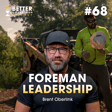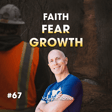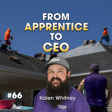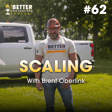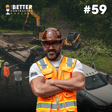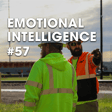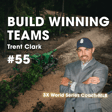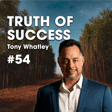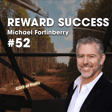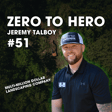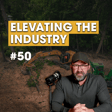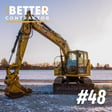Become a Creator today!Start creating today - Share your story with the world!
Start for free
00:00:00
00:00:01

Building a Stronger Safety Culture: How to Improve Operational Success Without Sacrificing Safety Culture
How can contractors align with large corporations to improve safety culture and operational success? Brent Oberlink sits down with Jay Keppler of Lanracorp and Sean Galloway of Pro-Act Safety to explore key strategies for fostering engagement, mitigating risks, and navigating the challenges of low-bid procurement. They discuss leadership, alignment, and autonomy in safety, while sharing insights on how companies can create a culture where employees proactively contribute to workplace safety.
#TheBetterContractor #CompanyCulture #Leadership #BlueCollarBusiness #Contractors #LandscapingBusiness #TeamBuilding #WorkplaceSuccess #Entrepreneur #SafetyCulture #SafetyContracting #TreeCare #Landclearing #Landscape
Transcript
Introduction to The Better Contractor Podcast
Importance of Safety for Contractors
00:00:14
Speaker
right, well, welcome back to another edition of The Better Contractor. Today, I am joined by Jay, who's my general manager at Lanarkorp. Jay, how are you? I'm great. And I've got Sean Galloway with Pro-Act Safety. Sean, thank you for joining us.
00:00:27
Speaker
Brent J, happy to be here. awesome Awesome. This will be a good podcast, guys. So for you contractors that maybe work more business to business corporation, you know, you've probably had to deal with procurement, you've probably had to deal with safety. Some of you smaller contractors, you still need to listen to all of this either way, because safety should and is important for you guys as well. So Sean is someone who I kind of consider a guru in the safety field. He's an advisor to several large corporations. If they're wanting to try to get things and do things better, Sean is who they may call. So a lot of experience in the safety realm from a whole variety of
Creating a Safe Work Environment
00:01:04
Speaker
different industries. So we're happy to have Sean on and kind of what we're looking at today, it'll be a hodgepodge of things, but I think this will be a good podcast. But we're going to look at how companies that, you know, work and integrate with these large corporations
00:01:19
Speaker
How can they work with them better? um What can they do to improve? How can they navigate? you know Obviously, if you're dealing in a low-bit scenario, but safety is huge, that has cost involved. So how can we basically work within in that framework? But then also, how can we also get our employees to buy into that safety culture? So you know we've seen a lot of things Jay and I have in in our industry and in our field where things maybe contradict, there's a little bit of a dichotomy, and we see it you know go down into the guys in the field, and it destroys their work ethic, or not work ethic, but they're their safety culture a little bit.
Pro-Act Safety's Role in Safety Excellence
00:02:00
Speaker
So anyway, our goal at Lanarkorp is always to make it to where the guys are not afraid to come forward, because the way we look at it is, if our guys will come forward with near misses and all these small things, we can then track that, chart that, and we know, hey,
00:02:16
Speaker
There's issues in these little fields and we need to fix those issues before that becomes no longer a near miss, but it's actually an injury or a fatality or whatever. So that's kind of what we're going to dive into today is this is an improvement type podcast. So Sean, we'll kick off with you a little bit first, but tell us just a brief history about you. What pro act is let the listener know, Hey, this is who Sean Galloway is. Thanks for that. Sure. Uh, my firm was established in 1993 by Terry Mathis who retired in 2021.
00:02:46
Speaker
I have a military background after the military and college. I got my start in engineering in England and then was recruited by Fleur Daniel, now Fleur, working primarily in process environments, chemical plants, refineries, etc. I then got involved on the process safety side of things, which fit my background pretty well coming out of the military, focusing on The rigor of compliance with dealing with hazardous chemicals in the operation. So as your crew didn't know five to come to work for Proact and we primarily focus on helping companies build the capacity in five areas. We call these the five capacities for safety excellence that system capacity. So a lot of what we do obviously is to prevent injuries.
00:03:28
Speaker
But we also have to realize mistakes are normal in a complex environment. Things don't always go to plan. So you also have to have recovery capacity. What happens if someone gets injured or what happens if things don't go to plan? There's deviation from expectation. Then we have to have leadership capacity to where our leaders are leading by example. They're making the right decisions to put people in the right situations. Then we also have to have engagement capacity. You mentioned buy-in. That's one aspect of engagements.
Aligning Safety with Business Objectives
00:03:57
Speaker
Then we have to have cultural capacity. Everybody has a safety culture, just may not be the one that they want. And then we also have to have strategic capacity. How do we make sure the business trajectory supports what we're trying to accomplish in safety versus like you said, the guys in the field feeling it's safety versus the business necessity. Because we know which one we is going to win. And that's primarily what we do across all industries. Oh, that's awesome.
00:04:24
Speaker
Um, so some of the questions I asked today, some will be from a contractor perspective. Like, how do I get my team to a certain level? And some of them may be a little bit more from like, because our, like our customer perspective. So a larger corporation is hiring people like us or other contractors. Um, so I'm curious to to know like your opinion. So like in our industry, we're in the oil and gas space. Um,
00:04:50
Speaker
If you're working for like Atlanta Corp, what have you seen has been some very good tools to basically for us to instill a culture, you know, with our actual field workers. So like for a lot of us, us example, you know, you know, we've got contracts, you know, all over the Midwest. So we may be five, six states away. We may see these people one or two times a month.
00:05:12
Speaker
you know So that makes it a little bit more difficult when you're not that hands-on to develop that safety culture and do that in the field. I'm just curious if you had any like key takeaways from like your time of how a company like ours or a company similar to us can kind of help promote that safety culture whenever the employees are remote. there's There are a lot of tools around assessing someone's risk profile because we all take risks. We kind of joke and say we all take calculated risks. We're just not all good calculators. So we all take calculated risks in different aspects. I know safety professionals that free rock climb, which I think is crazy. So we all take different types of risks and there are tools that you can ascertain the type of risk takers somebody is. You got to be careful about the ethics about determining that in the hiring process. But that's really where it starts. Are we hiring in risk takers into our organization? Because I've seen this happen in many
00:06:05
Speaker
situations where the the last frontier of a culture of safety excellence is what I call guarding the front door. You bring somebody in that's in a formal or influential leadership position, but has the wrong mindset. Could they take things in the wrong direction? Absolutely they could. But to me, if you look at, and I study some of the best and most successful military campaigns around the world, like the depression army, for example, what they all have in common are two things, alignment and autonomy.
00:06:33
Speaker
So in the military, you have something called the commander's intent. You know, this is what we're trying to accomplish, why we're trying to accomplish it. But you allow the autonomy on the battlefield but for the NCOs or the lower ranked officers to make the decisions we need to make to accomplish the objectives that's still in alignment with what we're trying to accomplish and why. So that's one of the things that I often find organizations could do a better job at, and that's determining and communicating and aligning people with what the objective really is. And if we stayed an objective by a result, no injuries, of course that's ideal. Uh, if you remember the old Dilbert cartoon, it was something like we said our incident goal is three last year. And in hindsight, it was a terrible goal because we had to injure two people to reach our goal.
00:07:19
Speaker
So of course we want no injuries, but if people aren't aligned and what it takes to make that happen, they will, with good intent, usually go in a certain direction, but they may not end up at the destination. So one of the tools that can be really helpful is to get people aligned with what success means. And success, of course, is no injuries, just like trying to, we're coming into the
Impact of Low-Bid Mentality on Safety
00:07:42
Speaker
Super Bowl soon. Success is one of these teams winning.
00:07:45
Speaker
But if all the performers aren't aligned with the different coaches on what it takes to make that happen, they will work hard but may not yield the desired results. So there has to be alignment with a behavioral definition of success. In other words, what do people need to do to produce no injuries? And that's a piece that makes a lot of sense when you think through it, but a lot of companies haven't clearly articulated and get people to buy in and really understand with this is what we have to do to produce that outcome while also keeping our head on a swivel because risks can come
00:08:23
Speaker
out of nowhere, especially low probability risks. So it's getting people aligned, making sure that they have some degree of autonomy to make decisions because we don't want people to be micromanaged, nor can you just proceduralize everything. So people need to be aligned with what we're trying to accomplish, what it looks like along the way, see themselves as actors in that strategy or objective.
00:08:46
Speaker
but also equip them with tools to continuously improve an understanding of the risks that they're exposed to. You said a few buzzwords in there. I like continuous improvement and alignment. So one one of my questions was about alignment actually. So we've been in business 16 years and I know one of the things that helped us get started in the very beginning is we fully bought in into safety from the get-go. And at that time, in that period, that was super important with a lot of our clients where they were choosing more best value at the time, meaning you were taking into account safety. We're taking into account all these different things. um And that's why we got chosen. We were kind of middle of the pack on price, you know, not high, not low, but we were fully bought in into safety. We were actually doing this stuff in the field. We weren't just checking boxes.
00:09:36
Speaker
And I have seen in the last couple of years kind of post COVID with a lot of oil and gas customers in your life where there's been a little bit of a movement back to procurement ah alone driving the decision for how to award contracts and safety being less of having less involvement. And I'm kind of curious,
Integrating Procurement and Safety Strategies
00:09:54
Speaker
you know, maybe what your take would be on that, how to kind of fix that, or there's that alignment, you know, between, you know, most companies are going to have your projects team.
00:10:04
Speaker
And maybe they're the ones that find, you know, the contractor or, you know, who they like. Then you've got the safety team who's saying, Hey, we're going to vet these contractors, whether that be on ISN that world or whatever they're using to, to vet that. And then you have your procurement team that says, Hey, we've got to still, you know, we're, we're moving from best value to low bid. Well, when they moved to low bid, how are they still making sure the projects teams getting the quality they want? How are they still making sure that the safety team is still getting the contractor they want?
00:10:34
Speaker
So kind of looking at that a little bit and saying, how can we align all of those? And how much does that low bid mentality hurt the goals of the projects team being quality? And how much does that hurt the safety team's goals of, you know, no safety instance, stuff like that. And one of the things I've seen, and this is not a dis to some of the verification sites, some are better than others, but a lot of them are kind of box checking. And we've seen it with us where we've seen a contractor win a low bid.
00:11:03
Speaker
And we were out in the field, all these pipelines crisscross over the place. And we'll see them out in the field like they're not doing any of the stuff that they checkmarked, you know, actually in the field. And there's nobody on site with them to know any different. So they're just doing it. And that's probably how they won that bid. So I'm curious your take on that alignment. This is more, I guess, of a maybe our customer type of a question, but what can they do better to try to align all three of those departments, in your opinion?
00:11:33
Speaker
Oh, I think aligning from the beginning, Alan Weiss has a term that he calls marketing gravity. and And I like this term that you have such an effective and successful brand that most of the business comes to you. And, you know, that's ideal for anyone, of course. You don't have to go out cold call, warm call. And, you know, 99% of our business that we've developed over the years is people pursuing us. We don't do any outbound reach because we have built a brand like that.
Case Study: Boeing and Safety Values
00:12:01
Speaker
So a lot of it has to do with establishing those relationships, being very visible, even things Brent, like you do here with this podcast, it can become a competitive advantage. The more that your visual and the more that your personal and company values are seen, that becomes synonymous with your brand.
00:12:19
Speaker
And it's it allows you to establish a relationship that gets ahead of procurement. Procurement has an objective within the organization. Ourselves, we don't respond to blanket RFPs because, well, for many reasons, and that's not always feasible for every organization, but a lot of it starts with making sure that your brand just absolutely shouts beyond a reasonable doubt that safety is absolutely part of who you are and and why why it makes you competitive in the industry. And some of that comes from being very visual. So that's part of on the front end of things is is establishing those relationships. Anything that you can do to where, again, like like you do here with this podcast, to where you're easily found. Even in my world, the people that
00:13:08
Speaker
Contact us want to be better so we developed that strategy i think it's sixteen or seventeen years ago that we we need to be found because people are searching so that led to books we started the very first safety podcast back in january of two thousand and eight called safety culture excellence and it still goes on today but We had to do a lot of things to where, wherever somebody was looking, we wanted to be found. We wanted to be that voice that's approachable that we could talk to. And so some of that's on the beginning. Now, aligning people with, with the objectives. You know, I hate to say this, but even if you look at what happened with the great organization that is Boeing.
00:13:51
Speaker
Boeing used to be an organization that I would refer to had strong signals and they became an organization of weak signals. When they move the operational leadership, those primarily engineers interfacing with the people on the floor that had the opportunity to seek out those weak signals, address them before they cause problems. When they move to more of a financial driven organization,
00:14:13
Speaker
Their values, I don't think they meant to change, but it changed in how decisions are being made on the floor. So there's a slow erosion of the core value of safety, in my opinion, it seems, over time. And that can happen in an organization when leadership doesn't keep their finger on the pulse. They're not doing skip-level
Fostering a Healthy Safety Reporting Culture
00:14:34
Speaker
meetings. They're not aligning people within their own organization.
00:14:38
Speaker
and To be blunt, shame on the executive team for allowing that to happen because they're not staying true to their own values when certain entities in an organization get so much power that it is incongruent with their established values. So there needs to be common checkpoints, gimbal walks, visits to the field, whatever term or tool you want to use to see does the work as planned represent the work is done.
00:15:07
Speaker
is how we're doing things, still how we've planned to go. And it's what's called normalization of deviance. We discovered that with the Challenger disaster in the mid 80s, 1986. So if there's deviation from expectation and we're not identifying it as works being executed, to me, sadly, there shouldn't be a surprise when we have a terrible event because the indicators are there if we're looking for them and if we're giving them the attention that they're due. But sometimes those indicators aren't loud enough, unfortunately, like you mentioned, you want to report near misses, but you also want to encourage a healthy reporting culture where people communicate mistakes that were made. Hey, this didn't go as planned. It wasn't a near miss. We didn't have something that the pendulum swung and didn't hit equipment or personnel. Things still just were kind of off here a little bit. And if, if that can be established in the beginning with the client, that this is how we operate as a learning organization.
00:16:03
Speaker
And we'd like to build those touch points even throughout the project to be able to offer that feedback. Now, some clients, they're not going to be willing to receive that kind of feedback. And also, I think, we'll unleash shame on them if they're not wanting to be a learning organization.
00:16:18
Speaker
ah but the more that leadership can go out and assess what's actually happening. A client of mine in the state of Missouri, the show me state, they have a tool that they call show me audits and they go out and show me how to operate that piece of equipment, show me how to de-energize that. Just to see are people still doing the work as planned or maybe they found what I call a better but not so common in practice. It doesn't introduce risk, but maybe there's a better way to do things. And we'll find them if we're continuously looking, but we'll also find those weak signals. And the signals are there. They manifest very loud in an injury when some somebody gets hurt or a terrible thing happens, but they're also typically found in other areas of operational performance. Safety is very loud, but typically you'll see those things manifest in quality, schedule,
00:17:10
Speaker
affecting cost if we're looking for those things. And that's where I appreciate when I go and speak at conferences, and there's a consortium of both contractors and clients that are regularly there together to talk through these things. And I think the contractors that put those on as well, because I work a lot on the side where the clients will occasionally pull their people in, but I think contractors could do a good job of that as well and inviting their clients in to have those regular safety conversations.
00:17:39
Speaker
I love that. And I think the the audits are so important. Like we do quite a bit of those at Lander Corp. And I think you've got so much safety, this documentation, you know, that you have to do, you know, and I think it's nice, you know, when people get out there in the field, actually spend not just like a 30 minutes, 45 minutes, but actually spend a majority of the day with the crew. So that way they can actually see, Hey, here's the behaviors, do some BBS type stuff, behavior-based, you know, safety, actually analyze, you know, those things, how they're operating equipment, you know,
00:18:09
Speaker
how they're handling a chainsaw or whatever industry you're in. um One thing I did kind of, ah you kind of got into a little bit and I had it down as a question as well, is one thing I've seen over the years, we try to have a very open like safety reporting process, meaning as much as possible, we try not to have that much discipline in there unless there needs to be.
Encouraging Open Safety Reporting
00:18:32
Speaker
um Some of our customers are that way as well, and some are not. And when our guys in the field feel like, Hey, I want to report everything to you near misses, you know, the BBS and stuff like that. What we've seen sometimes in the past is what they reported. And then all of a sudden the project gets shut down for a week to, to everybody to analyze it. Um, and it wasn't even really necessarily a major deal that the project needed to shut down, but the way the guys view it is you just now remove my paycheck for the next week. So that, that hit me, you know, however much an hour times 40, 50 hours, but then they don't ever want to report it again. And sometimes they may report it to us direct.
00:19:08
Speaker
they don't want us to report it to the customer, which we like to because you it it enlists their safety team. They work with our safety team and we come up with a better solution. So my question would be for you is how can that kind of be navigated, you know, from the customer's perspective or even, you know, my company or similar contractors to where It doesn't feel like it's a punishment based system, but we're still able to analyze and research that and the guys, the guys or gals still want to move forward, you know, next month and say, Hey, here's some near misses we had this month or different than last month, but we want to talk about those and they feel open and free to be able to do so. In psychology, they have a saying that all disappointment is based on the set level of expectation. So if you ever disappoint, it's because your expectations weren't being met.
00:19:54
Speaker
And what I find is we human do a much better humans do a much better job aligning other humans to results expectations than we do behavioral expectations. So I find where feasible having those conversations in the beginning throughout and a post job conversation as well to where we're communicating these are our expectations. This is how this is what we would see. These are this is how we can conduct ourselves. So a lot of that, if feasible, can take place in the very beginning of things to where we're talking about these are the behaviors that we expect. This is what we do. We're a learning organization. so We encourage people to report everything to us and we want to make sure that the reporting of this isn't going to negatively affect our operations or our work together because we want to be seen as a partner, not a vendor in this. So being a good partner, that means that we can learn from each other. So again, again, we're feasible is trying to have that conversation in the beginning, but also reminders throughout that
00:20:54
Speaker
This is who we are. So if you can have those regular touch points with the client to let them know and the client can have it with the contractors, you know, these are our expectations. How are things going? But the other side to that is maybe it's not the right word, insulating the employees from how the how the client responds to those things, because they're going to be looking to you to see how leadership responds to these things as ah as a leader within your own contract, within your own company. So we need to make sure that we establish the trust with the workforce. And in therapy, there's a model that they teach called PCB over T, and it stands for positive, consistent behavior over time.
00:21:33
Speaker
And that's how trust is formed in any relationship. So the employees are also looking to you to see how a leader responds when they have to report these things. And yes, we may take it on the chin with a client on this. And I want you to know that's exactly what our expectations are. So to me, it goes back to kind of aligning on the expectations for the results we want. We want no injuries on this job site. And we also want to be able to, back to that term, see where the weak signals are so we could talk about these events, these injury-free events that happen, so we can learn from these things together. But I too, Brent, have seen this, and I'll even see it in the Department of Energy world, which they were the ones that created human performance, and now it's being called human and organizational performance. And the very first principle in there is mistakes are normal in a complex environment.
00:22:23
Speaker
One of the other principles that they teach in this is leadership response matters. So I, too, have seen this. You have organizations that fully adhere to human and organizational performance principles. They understand these concepts, yet they use the term, beat their contractors up for reporting events. So it's it's incongruent. And again, where relationships are built and strong, we can where appropriate, call those behaviors out that this doesn't really align with what we agreed on in this project.
Culture vs. Compliance in Safety Programs
00:22:55
Speaker
And sometimes, as we know, we have to walk away from some clients if it's going to erode our own values. If if we how we respond to this is going to destroy the trust that the employees have within our own culture or safety culture, then that's going to have a long-term collateral damage effect down the road. so
00:23:14
Speaker
Part of it is, I think, setting the expectations, monitoring throughout, and maintaining the communication with the clients that this is who we are, and these are the behaviors we want of our employees, and how does your process with report was event reporting support this, or how might it conflict that so we can figure out a plan together? Because like you said, sometimes if it's willful, flagrant, sometimes discipline is needed,
00:23:42
Speaker
but I've also never seen a company punished into excellence. So we need to make sure that we're not doing anything that demotivates the reporting. And one of the primary demotivators is somebody feeling something bad is gonna happen to them, even if it's embarrassment. So we have to be constantly looking for, are we doing anything that demotivate? And if it's on the client side, we need to establish a relationship where it's okay to talk about those types of issues and also get aligned with what happens if we if we face them.
00:24:11
Speaker
yeah Sometimes you have to build that into the contract language. Yeah. No, I love that. And one of the reasons I connected with you as a guest for this is your focus on culture, because to me, that's really where it's at. As long as you have the programs and you have all those things, you have to have that and that's great. But if you don't have culture, it's kind of one of those things like if you have the programs and you're watching the employee at all times, they'll probably do it. Well, most employees are not watched 24 hours a day, seven days a week.
00:24:41
Speaker
So that's when the culture steps in is that is hopefully when they decide, you know what, I'm not just doing this because company X said, I actually buy into this and I believe it. And it's actually part of who I am. And then that's what actually gets the safety done, even when no one is looking, which is why we focus. And I think why you probably focus so much on culture, which I, which I love. Um, and it kind of takes me back. We met actually through a ah client we both have, and we had an incident two years ago or so.
00:25:09
Speaker
And that client that we shared together was one of the ones that responded the best to the instant. And we had another client that did not respond that way. And I've seen the culture with our guys be drastically different with those two clients. Client A, the shared client, they were extremely interactive. Like their safety team wanted to be a part of this because the incident was something on a piece of equipment that almost every single contractor inside that that works for them has and uses on a daily basis.
00:25:39
Speaker
And so their approach was, you know what, this could have been us. It could have been any other contractor. It was a weird incident and we want to work with you guys to make sure that we can share this with others and hopefully prevent that incident from happening anywhere. There was no punishment involved. Um, like they were very involved in getting it done. There was like another company where it was more of a punishment based system. We didn't work for them for quite a while. Well, then that tells my guys, you know,
00:26:07
Speaker
Basically don't be truthful about this stuff. So, which we don't want, because then we don't learn. So
Shifting to a Genuine Safety Culture
00:26:13
Speaker
very much like you mentioned earlier, that the psychology of it, that was very much one of those things that showed that psychology difference of, you know, being fully invested, actually caring, actually diving into the root cause, fixing it, sharing it with the entire team. Instead of, Hey, you know what? You guys had this mess up. We'll see you later. You know, there's no lesson or and there's nothing learned in that, in that instance at all.
00:26:35
Speaker
And that should have been shared with others. So anyway, I love that part of it, the psychology of it. One thing, Jay, I'll let you ask next question. One thing, um, I was curious of is like, I call it box checking, you know, and we've alluded to like the safety culture and all that already, but I was kind of curious what you've seen or how you would recommend, like if it's a contractor listening, let's say they have all the programs, they have all this stuff, but when they go out in the field, they really see that, Hey,
00:27:02
Speaker
We're really just checking boxes. We're not actually, my my employees aren't engaged. That kind of goes back to culture, but what would you think is a good way for that contractor to build a little bit more of a culture that says, you know what? We're not actually box checking anymore. You know, we actually want to do this because I want to go home safe. I want my coworkers to go home safe, almost like a buddy system where there's an accountability process between employee A and employee B. What would you say to that contractor that's struggling with that?
00:27:31
Speaker
I would answer that. I think his name was mayor developed a model that said there's three reasons why people resist change. And what we're talking about is change because change is the only thing that's constant within cultures than organizations. And he said the three reasons are people don't understand the change. So we haven't clearly communicated why we're doing this, how it adds value to the business, to them personally, to the people that they care about. So they need to understand the why behind PPE requirements, procedures to follow, et cetera.
00:27:59
Speaker
The other two reasons are they don't like it or they don't like the person bringing the change, which highlights that humans respond emotionally to change before they respond intellectually or logically to change. So we have to pay attention to that, that we have to communicate what were what our expectations are in a way that is memorable to them. And people remember stories and pictures, not facts and figures. And we do a lot of facts and figures communicating from a safety standpoint. So we need to be telling stories. I like the idea of using scenarios to where we teach a lot of something we call Leadership Safety Coaching, where we teach leaders, people leaders, how to become performance coaches. Now, selfishly, we target it towards safety objectives, but it's performance coaching in general. And we leverage scenarios because we want them to hear their peers and we want them to talk through. You walk onto this job site, this is what you see, and maybe there's another foreman or supervisor there, how do you handle this? Getting people to talk through those things is a very effective tool. We tend to do a lot more training on how we want things to go. In the military, you train like you fight, and you fight like you train. There's a lot of training about what happens
00:29:07
Speaker
if plan A doesn't work. Now we have to go to plan B. So you train around those things. I think it's effective to give constant, and it doesn't have to be training or education, but just constant conversations around certain scenarios and how would we approach these things. Because you're right, what people do when the boss isn't around is a part of every organizational culture. And one of the things that affects behavior is the environment. So I like to joke and say, if you're married or you might be married someday,
00:29:37
Speaker
Did you, did you change your behavior when you're meeting your potential in-laws for the first time? It was that different than if you were going out for, to have dinner with friends? Of course it is. So the behavior is a product of the environment. And we have to realize that that happens with everyone. Jay, I'll let you ask the next question, man. Okay. Yeah. So we, you know, one thing we do and we feel we do very well here is the
Balancing Safety and Production Efficiency
00:30:01
Speaker
culture. So we've got everybody on board, our foremen, we, we,
00:30:05
Speaker
Got them following all our safety processes from the paperwork, but more importantly, that communication to the crew on a daily basis. They have their tailgate meeting, they talk about it. um We know safety takes time, and time is money, right? So we're trying to find that balance of time and money versus production, because we're looking for our customers to go after us for our best value, not necessarily look at just low bid,
00:30:36
Speaker
And what, what do you think we could do differently to maybe train our foreman to, to look at that difference of, of time versus production? If you look at what's happening right now in America with the department of government efficiency, and that's, you know, that's a political football, but what they're trying to do is they're trying to streamline the decision making and remove unnecessary bureaucracy.
00:31:01
Speaker
I find a lot of organizations fall into that same trap with the safety mindset. They fall into the mindset that more is better and more isn't always better. Better is better. So sometimes when you look at strategically, how do we advance the conversation, the culture, the performance and safety?
00:31:19
Speaker
Sometimes the answer is, what do we need to stop doing? What are we doing that's non-value added? What are we doing? In Lean, there's a process called value stream mapping. So you look at a particular process and you say, what adds value? And then those are the components you write down. Then what doesn't add value, but is necessary? Maybe it's regulatory reasons. And what doesn't add value that we can stop doing?
00:31:41
Speaker
And even going in and having those conversations around what are we doing that makes it difficult to accomplish our objectives? What are we doing that may even seem dumb from a safety standpoint? And again, some of it we may have to do these things. So part of it is understanding a day in the life of the foreman. And sometimes leaders all with great intention can rise up in an organization, even maybe coming from that role. And they forget about what the day-to-day realities are of that foreman. And sometimes, well, the reality is what we've put on administratively on the foreman has been increasing over the past several years, decades, if you will. So the foreman whose primary responsibility is to be out there leading, making decisions, coaching their people, et cetera.
00:32:28
Speaker
they get so far removed from that because they have to sit in the truck or they have to fill out paperwork. So sometimes we have to look at, are there some things that we can stop doing that is making it difficult or demotivating our ability to be successful with this job, safety being one of that, performing, keeping you know performance where it needs to be for profit, all of that. So that's the first thing I would look at.
00:32:48
Speaker
The second thing is you're wise to identify the criticality of foreman because I have found regardless of industry and over two decades doing this the most important people to shape performance and culture in any area of operations are the first line supervisors. the foreman. Yet they are also the most under trained, under resourced, underutilized individual in our organization. So we're not doing a good job setting them up for success. And part of the way of setting them up for success is what I call maturing the safety thinking. We have to help them think more advanced about things because all progress begins by thinking differently. So we have to help our leaders think differently about this.
00:33:28
Speaker
But you're right. it's It's the balance and it always will be about how do we make sure we're still hitting our profitability safely. So it's combining those two and and some companies actually call it safe productions safe activities. So safety is not something else we're doing.
00:33:44
Speaker
And if it is something else we're doing and it's not value added, is there something that we can stop doing? So the more we can understand the day in the life of what those foremen are experiencing and the more that we can continuously educate them and have accountability conversations around what we're trying to accomplish.
00:34:00
Speaker
To
Foremen's Role in Safety Leadership
00:34:01
Speaker
me, accountability is making sure people are doing the things necessary to produce the results before checking to see how did things turn out. So if we're not holding people accountable throughout the day, we shouldn't hold them accountable at the end of the project. But when I look at it and say, if we're not getting the performance we want out of Foreman, it usually falls into five areas. One is they're unwilling to do the things we need them to do. And sometimes Deselection might be the only answer there if somebody's unwilling to be the leader, but usually that's few and far between. The next one is they're unaware. We haven't really sat down and said, these are your most important roles, responsibilities, and results from a safety standpoint. So we haven't made them aware. The next is they're unable. I mentioned coaching. We want our leaders to be great coaches, but we've never taught them skills about how to have those conversations, how what to observe, how to give feedback.
00:34:55
Speaker
the The fourth one is that they're unaccountable. We're not having those accountability conversations that what can we do to accomplish this project safely? And bait back to the principal's approach to it, the principal is we don't want to put anybody unnecessarily in harm's way, but there's always going to be risk that we're facing on a job site. So sometimes have that conversation around what do you, Mr. or Ms. Forman, view as acceptable risk and what do you view as unacceptable risk?
00:35:23
Speaker
because sometimes that alignment isn't there with how people at your level may perceive what's acceptable and what's unexpected. because the mindset of we won't do it if it's not safe can work against a leadership team if we have it defined well what does safe mean because safe doesn't just mean free from all risk safe means that we're aware of the risks we know what precautions to take when facing those risks and we're regularly taking those precautions so we have to get people aligned with it's not a matter of stop or pause the job if you feel unsafe because
00:35:55
Speaker
People could stop walking because like I can't necessarily see that it's snow on the ground. So I'm not going to walk then. So it's that balance of what are we trying to accomplish? Still maintaining the healthy reporting and the speak up culture that if it doesn't feel right, trust your gut and let's work that out. But we also have a business that we have to run here. So sometimes that goes into not pursuing certain types of work where feasible. ah But if we just have that short term mindset, then we're going to become very fixated on the task at hands. And that's when low probability risk tends to climb in, which flies under the radar of common sense and experience because we're so focused on that task and the pressure to get it done that day that we are not paying attention to keeping our our head on the swivel. Really in in summary, without meandering too much off off topic here,
00:36:47
Speaker
It's getting aligned with our form and about what they're actually facing. Are we doing things that make it difficult to accomplish the they both priorities of profit and safety, but developing the comfort level within the supervisors and the skills and the know of what to look for and when to speak up if we might be putting things might be putting people in harm's way. It goes back to we have to you know we want to be a successful business,
00:37:15
Speaker
performing our work safely as part of that success and making sure that they know that it's okay to call a pause if we don't feel that we're going to be able to accomplish these things. But to me, you know, to me it comes back to maintaining the mindset within our form and that they are a leader out there in the field. And this is how we expect our leadership to behave.
00:37:41
Speaker
And too often, we'll find that the foremen views themselves more of an extension of the workforce than extension of management and leadership team. So the more that we can involve them into company decisions, and this is why we make these decisions, the more that they can see our intent as leaders, not just see our actions.
00:38:01
Speaker
And Deming taught a long time ago, the father of quality, Dr. W. Edwards Deming, that people support what they help to create. And if you really want to engage the foreman, they have to feel as though that they have a voice in how decisions are being made in the field. And we have to constantly be checking in, are the decisions they're making aligned with who we are as an organization. Not be so quick to beat them up if they make the wrong decision because they too will make mistakes, but to be able to have those frequent check-ins to talk me through why you're approaching the job
Aligning Field Workers and Safety Professionals
00:38:33
Speaker
this way. Talk me through why you made this decision to help so we can monitor how they're making their decisions and how they're executing in the field. I love that. And it kind of leads to my next question a little bit. So it's very similar, but slightly different. so
00:38:46
Speaker
A lot lot of that was excellent for someone like Jay or myself, you know, where we're the managing team for that foreman. And a lot of industries, the customer's pretty heavily involved as well, especially on the business of business side. If you are leading a safety department at maybe the customer level, one of the things we get a lot of feedback from like our foreman, and not just here, every industry that works in the field, they oftentimes view like,
00:39:14
Speaker
you know, the ivory tower or those, you know, those who went to school for safety, but have never walked in my shoes, making decisions for me out here, but never stepping foot out here. I understand that. I also understand there is a lot of value they're bringing to the, to the field as well, but both sides. How do you think if you're a safety professional and you're sitting in the office and you're trying to make decisions, safety procedures, what have you in the field for someone that does it on every single day is what they do for a living.
00:39:44
Speaker
How do you meet in the middle, in your opinion, you know, it's where that employee in the field now says, you know what, I respect Sean and safety because what he's doing, he actually cares, he gets me, he actually feels like you're just as invested. So it's not just, you know, Sean's out here dishing out all these different forms and chat boxes for me to fill out for 45 minutes every morning. Sean's actually doing this stuff to actually keep me safe in the field. How do you speak to that particular professional battling that to best meet in the middle there. Safety professionals have a brand and a brand is how you associate with a product, a person, a company, a team, EHS leadership team as an example. And you have to be constantly monitoring your brand and how your brand is perceived. And there can often be a disconnect. There's more of a disconnect opportunity if like you're saying, they're just saying in the office and they're not going out and seeing how work is being determined. In a process environment, you have something called management of change and there has to be validations.
00:40:47
Speaker
in involving certain stakeholders to sign off and review things before we implement this change. I think taking that mindset is a good approach. Now, the top level safety professional can't always be out there in the field, like the CEO of an organization can't always be out there in the field. So you have to build your your lieutenants. You have to build a consortium of individuals that feel comfortable telling me the emperor has no clothes. So you have to bring people in.
00:41:13
Speaker
and whether it's through the concept of learning teams and human or organizational performance, where we involve people that are at the pointy end of the stick. So we're not making these decisions at the blunt end of the stick. So however feasible we need to go see, and that's the concept of Gemba and lean manufacturing. You have to go where the work is being performed to engage people and shame on the safety professionals. If there's no mechanism or channel to be able to validate how decisions affect the people performing the work. ah Strategically, there was a group based in Paris over years ago, and that was one of their
00:41:48
Speaker
One of their primary strategic priorities was involving EHS in project deployment because they would stand up certain facilities to support their client base for a few years and the safety professional wasn't brought in. So of course you'd run into issues that put people in harm's way.
00:42:05
Speaker
so That's an obvious example. When we implement a policy or procedure, if we're not involving people that actually perform that work, there's going to be points of conflict. So however feasible, we have to realize that how we are perceived is also going to affect how people support our decisions. And safety professionals evolve in organizations, and all three of these are wildly important. But the first level is what we refer to as a grunt.
00:42:35
Speaker
Doesn't mean to sound derogatory, but they manage the paperwork. They do all the heavy lifting and everything. And they're all needed in certain aspects of an organization, especially larger ones. The next level is they're perceived as a guardian. They're owning the programs. They're helping leaders take some responsibility. They're guarding as decisions are being made. And the final level is a guru, a true subject matter expert, somebody that's like general counsel. They don't run the business.
00:43:02
Speaker
But they advise in the decision making process to make sure the decisions are going to be carried out effectively successfully. So as that leader evolves to that guru state, they still need to keep themselves grounded. Myself as somebody that's a subject matter expert in safety excellence.
00:43:21
Speaker
Two weeks ago, I was working with an an oil crude hauling organization. And for almost a full shift, I drove her out with one of these truck drivers and went to their locations as they were picking up crude and and then releasing it at some of their stations. And I got a day in the life of, and I'm the CEO of my organization. So if I can do that, then safety professionals wear feasible. And sometimes they're not allowed to, they're they're not allowed to travel, to go visit locations, to go drive them right away to see the reality of how we've set contractors up, then they need to find people that can be there their voice of reality in the field. So if we're making decisions and if we're not checking how those decisions affect how the work is supposed to be performed, we should be no surprise and things don't go to plan.
Short-term Savings vs. Long-term Safety Investments
00:44:11
Speaker
Oh, that's perfect. That's perfect. So Sean, one final question I had and putting myself kind of back into the safety person's role is,
00:44:20
Speaker
What we've seen a lot in the industries is there's this focus lately, especially on short-term savings. And I don't feel like I said before, we're huge on stage, we're huge on safety culture, doing things the right way. um That's who we want to be as a company. So that is a little bit more of a long term investment and how I've always viewed it internally. And like even internally, we do not low bid our stuff out like the vendors we have, we don't really go through and low bid it. We look at best value. We look at relationship. We look at who aligns with our core values.
00:44:52
Speaker
cost is obviously a factor, but as long as like, if we're, if the price range is 50 to 100,000 and who we want to use is 200,000, we're going to have a conversation. But if it's 125 and under, we're probably still going to use them because they give us more value. So I guess my question there would be, if I'm a safety person and I'm battling like with procurement, for example, about like these short term savings, how can I sell to them that there's costs involved long-term. So this is a long-term investment in our culture and our safety at whatever entity company they work for. But not doing this now will result most likely in you know increased safety issues, which then costs my team more hours. Now you're paying my team either the way as a safety professional, if I'm salaried, but our team has a lot more time now involved in the field dealing with issues and stuff like that.
00:45:49
Speaker
We have to work with landowners a lot. So it's my quality issues affecting them, giving them then a bad eye or bad view of my company, both companies, the contractor and the customer. The long-term implications of choosing low bid matter. um So I'm just kind of curious your take on that. If you're that person in that industry, what would you say to them to kind of help them navigate those waters? And brent are you asking this if you're a safety professional in an organization?
00:46:19
Speaker
Okay. I think it's a multi-pronged approach. One is you have to ascertain how you proceed back to that grunt guardian guru status. And if you're just viewed as a grunt to the procurement folks, your voice isn't going to carry much weight. So part of this is increasing your own brand and how you're perceived in an organization, which is not going to address the short-term issues. So you also then have to look at it that people trust data and have a little opinion of opinions. And if we're bringing this from an opinion standpoint to procurement, again, it's not going to carry much water, it's not goingnna it's not going to hold its own. So you have to, let me let me pause and say that I've worked with organizations that invite their procurement people into kind of a lunch and learn, if you will, to really understand the risk profile. So the procurement folks which serve a value in an organization can understand how their decisions downstream affect different areas of operations.
00:47:16
Speaker
But over time, you can't address that directly unless you have a leader that has some altruistic perspectives about the importance of safety as an individual. And if that position is rotating so often, which tends to happen in a lot of organizations, then you have to figure out how you can go above. And that has to go to the board level, to the ah to the executive level. And unfortunately, sometimes we don't see those things occur until something significant happens. That would be a major injury or fatality. I worked with one of the largest hospital systems, and they had a change in one of the board members that came from one of the super major oil and gas companies. They're used to seeing 0.0-something total recordable incident rate, and they were looking at the hospital system that had a 4-point something. They were appalled. How is this?
00:48:08
Speaker
But when that board member started asking questions, people pay attention to what the bosses are paying attention to, all of a sudden the priorities changed. So it's a multi-pronged approach, but also I think it needs to be said that not all organizations value safety like we value safety. All of us on this podcast today and sometimes ethically,
00:48:33
Speaker
it may not be best for you to work for an organization that doesn't value that. That's the easy out on that, that if it's if it's something that's going to compromise your own values, your own ethics, I would advise the the safety professional, you might need to make a change there. We all, most of us in safety, want to make a difference, so you have to look at it back to what's my sphere of influence.
00:48:56
Speaker
You don't have a lot of control over operations and the executives unless you have that proverbial seat at the table. So you need to work to understand the business, to speak the business language. So the business executives and leaders see yourself as a partner to them accomplishing their goals effectively. And the more we're pushing at them with problems without solutions, the more that we're just talking about failures without also investigating our successes,
00:49:23
Speaker
the more we're speaking the lingo of the safety professional versus being perceived as a business professional that's passionate about safety, the more we're gonna be viewed as that guardian or grant level. So it takes time to get to make that happen, and it has to be a multi-pronged approach, and you have to, and even being strategic is about making trade-offs, small bets, and what works to influence one procurement leader's perspective on something may not work to another,
00:49:51
Speaker
So if you can, you have to even try to establish those relationships internally within your peers within the procurement department to understand what's important to them and speak about your safety objectives and the way that they can associate with. If they have teenage kids, imagine your teenagers working out here on this right away, wouldn't we want to set them up for success? you know there's There's some ways that you have to be careful about how people perceive that as maybe trying to manipulate, but we're trying to influence after all, because we have a lot of control. So it's multi-pronged looking at it from, coming at it from multiple different levels. But we also have to look at this back with data to show them with a high probability that
00:50:34
Speaker
For example, if we launch and don't change out this three cent O-ring, you know, we have a potential catastrophe of losing seven astronauts. So maybe even going back as a leadership team and encouraging people to watch like the Challenger Netflix miniseries, or yeah that's a good one from a contractor client perspective. And I think that should be required watching for or viewing for people that are in procurement and operational to realize how the decisions we make, how it affects how people carry out the work.
Risks of Low-Bid Contracts
00:51:08
Speaker
Yeah, that challenger, I've i've seen bits of that. Now I'm going to watch the whole thing, but that's that's a perfect one. so I'm just old enough to barely kind of remember all of that being in the news a bunch of the back then. so And I know to kind of further your point,
00:51:22
Speaker
You know, as a contractor, as someone who works and talks a lot with other contractor owners, you know, the one thing I've seen with a lot of us is, you know, with low bids, this is not always the case. But a lot of times, it seems like the low bid is actually a mistake. Which is, we we had one customer tell us one time, and I appreciated their approach to this. They said, we'll usually try to get at least five bids.
00:51:45
Speaker
Immediately we toss out the lowest one and we toss out the highest when we look at the center three. And I've always thought when they told me that the one time, I'm like, that's the way to do it because the lowest one's probably a mistake and the highest one's probably a mistake. So let's toss them out. We'll look at the center three. um But, you know, I go back to as ah as an owner and talking to other owners on that low bid, if you don't do that, it seems like a lot of times it was a mistake, which leaves the owner then at a crossroads of do we bail on the project as option one?
00:52:12
Speaker
option two, do I cut costs as much as possible to at least not lose a bunch, maybe break even, probably not make a profit. Um, you know, you kind of have that dichotomy there of what do I do? And obviously if the customer or contractor stays with it, they may choose option two, which then just common sense would say you're increasing your risk for a safety issue or a quality issue or something because you've cut everything out. You know, maybe you're not doing the safety audits as much as you normally would because they cost money. Like Jay said earlier,
00:52:43
Speaker
You know, we do those all the time, but you know, for us, we have usually two travel days to send an auditor out a day on site. So you got two or three days per diem and two or three days worth of wages just to do an audit. Will everyone do that on every project? If they're losing money, I don't know, but that's the stuff you kind of got to look at. So anyway, just kind of my closing thoughts on
Conclusion and Final Thoughts
00:53:03
Speaker
that one, Sean, thank you for jumping on. Um, you know, over the past we've worked and dealt with a lot of different safety people.
00:53:10
Speaker
You were one of the ones that I admired a lot for like mindset, being able to explain the importance of safety outside of the box, checking outside of the normal documentation, the legalistic part of it, but bringing it home to mindset, bringing it home to culture, bringing it home to actual engagement. So Sean, super, super appreciate you jumping on. Appreciate what you're doing in the industry as a whole. And gentlemen, thank you for what you've dedicated yourselves and your organization to as well. And all the value that provides for the people that you work with National Safety Council, we we highlight that people are much more likely to get injured outside of work than they are at work. And the more that the things that you're doing to create that mindset are going to help protect their people when they're with the people that they love the most who are actually more likely to get injured than the people they work with. So thank you for what you do. Yeah, no, I like that. We had we had one of our foreman a couple over the past be like, you know, because like, in our industry, we do a lot of like tree cutting and right away clearing. And they'll be like, man,
00:54:09
Speaker
I never even thought about putting chaps on or doing this or doing that at home when I'm cutting a tree in my yard. But now I'm getting ready to start up a chainsaw and I'm like, shoot, I don't have my chaps on. So they'll go get a pair of chaps or borrow a pair from work or whatever. But you're right. That safety culture, if it's a true culture, travels with you to home or to wherever you're at, not just at work. So, Sean, thank you so, so much. Great podcast. Absolutely loved having you on. Jay, thank you for jumping on as well. If you guys enjoyed the podcast, please do share it with others. We don't charge. We don't run ads.
00:54:40
Speaker
It is all just to get out there and help you guys. So please do share the show. Thank you all.
